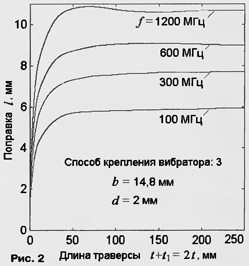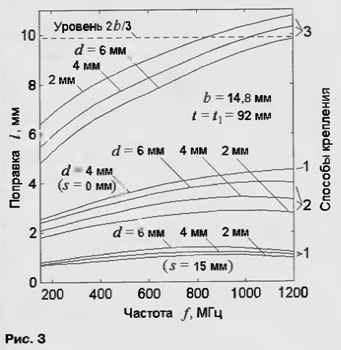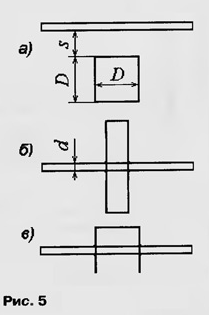
|
|
ENCYCLOPEDIA OF RADIO ELECTRONICS AND ELECTRICAL ENGINEERING On the influence of a metal traverse on the operation of an antenna. Encyclopedia of radio electronics and electrical engineering
Encyclopedia of radio electronics and electrical engineering / Antennas. Theory In the proposed article, the authors tried to clarify the recommendations available in amateur radio literature regarding the effect of a metal antenna traverse on a half-wave vibrator. As a result, correction values for the length of the vibrator, suitable for practical use, were obtained depending on the ratio of the "vibrator-traverse" dimensions, the operating frequency and the distance of the aibrator from the end of the traverse, for three main methods of its fastening. The metal bearing traverse, on which the elements of the vibrator antenna are fixed, is located in the near field of the antenna and can have a significant effect on its parameters. In particular, the dimensions of all elements of the "wave channel" antenna, calculated without taking into account such influence, require correction. In the literature available to the authors, no detailed analysis of this effect, methods for taking it into account, or effective, labor-intensive correction have not been found. In the descriptions of antennas, at best, there is an indication that the dimensions are given for mounting on a metal traverse of a certain diameter [1] or there is a remark that in the 432 MHz band, the method of attaching the vibrators to the supporting structure has a great influence on the properties of the antenna [2] . In [3] it is recommended to lengthen the vibrators by 0,5...1% in the presence of a metal traverse, and in [4] a recommendation is given on the need to take into account the influence of the traverse by increasing the calculated length of the vibrators by 2/3 of the traverse diameter. It is noted in the book [5] that for the reflector and the last director the condition "2/3" is valid only if the corresponding ends of the traverse protrude by at least five traverse diameters. In the Russian translation of the book by K. Rothammel and A. Krishke [6], the approximation and limitations of the empirical rule "2/3" are noted and the influence of the method of fastening the element, as well as the thickness and shape of the cross section of the traverse is indicated. In the same place, with reference to the works of DL6WU [7, 8], a brief table of corrections to the length of the passive elements of the "wave channel" antennas in the 145 and 432 MHz bands is given. Methodology and models The influence of the conductive traverse on the resonant length of the half-wave vibrator was studied by electrodynamic simulation using the WIPL program [9], which is used to analyze radiating and scattering structures of wires and plates without taking into account losses. Three typical methods of symmetrical fastening of a round vibrator to a hexagonal traverse were modeled (Fig. 1): 1 - the vibrator is isolated from the traverse, the axes of the vibrator and the traverse do not intersect; 2 - the vibrator is isolated from the traverse, their axes intersect; 3 - the vibrator is connected to the traverse (there is a good electrical contact - welding), the axes of the vibrator and the traverse intersect.
It was also believed that there was only one vibrator on the traverse and nothing but the traverse affects its resonant length. The effect of non-resonant vibrators in multi-element antennas and their length correction will be discussed below. The exact resonant length of a half-wave vibrator of a given diameter with symmetrical excitation at a given frequency was determined by the condition X=0, where X is the imaginary part of the complex input resistance Z=R+jX of the vibrator. First, the resonant length Lo in free space (without a traverse) was determined, and then, similarly, the resonant length L under the given conditions of fastening the element to a given traverse. The required correction value was calculated as l=L-Lo or as a percentage as σ=(l/Lo)·100%. The influence on the resonant length of the method of fastening the element on the traverse (1, 2. 3), the diameter b of the equivalent traverse of circular cross section, the length of the protruding end of the traverse t when the vibrator is attached at its end, the diameter of the vibrator d and its length (indirectly through the frequency f, which determines wavelength X), as well as the influence of the gap s between the isolated vibrator and the traverse. In table. Table 1 shows the intervals of relative modeling parameters, the results of which are used further to obtain empirical calculated relationships. For a hexagonal traverse with vibrator mounting method 3, size b=1,09D. An estimate of the "acting length" of the traverse, i.e., such a distance of the vibrator from the ends of the traverse, an increase in which practically does not lead to a change in the correction value, can be made using the simulation results shown in Fig. 2. Taking into account the limitations of the WIPL program, for modeling in the frequency range of 150 ... 1200 MHz and in the entire range of traverse diameters of 7,4 ... 29,6 mm, the effective length t1 is taken equal to 92 mm.
Simulation results On fig. Figures 2 - 4 show selective plots showing the nature of the dependences of the correction on the simulation parameters. Let us note some general regularities. The presence of a metal traverse, the thickness of which is greater than the thickness of the vibrator, with all methods of fastening, leads to a noticeable electrical shortening of the vibrator, i.e., to an increase in its resonant frequency. To restore the resonant length at the previous frequency, it is necessary to increase the calculated length of the vibrator by the amount of shortening l. The analysis showed that this effect is due to transverse currents of the traverse. Therefore, it cannot be detected by traverse simulation using programs for thin conductors (MININEC, ELNEC, MMANA), where only the longitudinal currents of the conductors are taken into account, even if a sufficiently large wire diameter is specified. From fig. 2 it follows that the longer the vibrator, the smaller the value of the correction l. At frequencies of 600 and 1200 MHz, the effect of the resonance of the traverse is noticeable, although it is insignificant. The influence of the traverse is most pronounced in the connections made according to method 3, and when mounting the vibrator without electrical contact, it significantly depends on the size of the gap s in method 1 and almost does not depend on the size of the gap (within reasonable limits) in mounting option 2. The correction value for a given thickness of the traverse depends differently on the thickness of the vibrator (Fig. 3): for connections with contact type 3, with an increase in the diameter of the vibrator, it noticeably decreases, for connections of type 2 without contact, on the contrary, it increases, and in method 1 such dependence very small and practically absent at zero clearance. The effect of frequency is reduced to a moderate increase in the value of l with increasing frequency - 1,5 ... 2 times in the range of 100 ... 1200 MHz.
The thickness (diameter) of the traverse has the strongest influence on the correction value (Fig. 4). So, at a frequency of 800 MHz, a vibrator diameter of 2 mm (resonant length without a traverse 176,2 mm) and a traverse diameter b = 14,8 mm, the correction was 9,74 mm (which, by the way, in this case is close to the value 2b/3 , cited in the literature as a recommendation for correcting the length of any vibrator with a connection of the 3rd type). A twofold increase in b led to an increase in I by 2,47 times, and a twofold decrease - to a corresponding decrease in l by 2,59 times.
A significant increase in the correction when the place of attachment of the vibrator is removed from the end of the traverse is determined up to distances of 3 ... 5 diameters of the traverse (Fig. 4), and if the vibrator is mounted at the very end of the traverse (t = 0), then the value of l can be approximately 60.. .70% of maximum. On fig. 5 shows sketches of several models with rectangular and square traverse sections.
On the model in Fig. 5a, calculations of corrections are made for comparison with a similar method of fastening (1) on a hexagonal traverse with the same circular cross-section diameters equivalent to the 3rd method (b = 14,8 mm). This comparison is shown in Fig. 6, from which it follows that in this case, when the vibrator is parallel to one of the faces of a square traverse, the influence of such a traverse is noticeably stronger. The diameter of a circular traverse, equivalent to a square traverse with fastening made according to method 3 (Fig. 5, d), is considered as b = 1.14D.
Practical application Based on the results of modeling for different ways of attaching the vibrator to the traverse, empirical expressions were obtained that relate the value of the required correction to the initial data (dimensions and frequency). To find these dependencies, multiple regression procedures were used (Stat-graphtcs plus v.2.1 [10]). The root-mean-square error in calculating the relative value of the correction l / b according to the formulas is 0,0115 for fastening method 1, 0,00758 for fastening method 2 and 0,0132 for method 3. The calculation formulas are very cumbersome and are not given here. According to the formulas obtained, calculation programs were compiled. Program texts: Russian-language boom_r.bas and English-language boom_e.bas in Turbo-Basic, as well as executable files boom_r.exe and boom_e.exe, respectively, can be downloaded hence. Data entry is made in the dialogue mode with restrictions in accordance with Table. 1. Since the programs work on relative sizes, the frequency range for calculations is not limited by the simulation range.
In table. Figure 2 shows for comparison the correction values (mounting method 3) for a frequency of 432 MHz, obtained by DL6WU [8] for an unknown element diameter d and calculated using our program for three values of d.
Non-resonant vibrators The results obtained can also be used to correct the length of non-resonant passive vibrators of "wave channel" antennas. To do this, you first need to calculate the relative value b of the correction for a resonant vibrator under the same conditions. The boom program converts the absolute correction l (in millimeters) into relative σ (in percent). Then the same value of the relative correction l is applied to the calculated (excluding the influence of the traverse) length of the passive vibrator and, as a result, the absolute value of the correction is obtained. For example, the calculated length of a reflector with a diameter of 20 mm at a frequency of 50 MHz is 3060 mm. Traverse diameter b=80 mm, t=140 mm, fastening type 3 or type 1 with gap s=20 mm. Calculation according to the boom program gives a correction l=32,74 mm (σ=1,15%) for type 3 fastening, l=8,44 mm (σ=0,3%) - for type 1 Therefore, in the first case, the reflector it is necessary to lengthen it by 1,15% of its estimated length, i.e. by 3060-0,0115 = 35,2 mm, and in the second - by 0,3% of the estimated length, i.e. by 3060 0,003 = 9,18 mm. This technique, with a phase shift error of up to ±3°, is applicable to vibrators that differ in length from resonant ones by ±10% or less. The influence of the traverse without correction can lead in this case to a phase deviation of up to ±15°. The influence of other vibrators is also easy to take into account using simple wire antenna simulators, such as MININEC, etc. The suitability of this technique was tested in practice, in particular, in the development of stationary 11-element "wave channel" antennas in the range of 820 ... 875 MHz for remote cellular subscribers. The calculated lengths of all elements (d = 5,6 mm) were increased by 2,3% for installation on an aluminum traverse with a diameter of 15 mm according to method 2 with a length of protruding ends of the traverse of at least 60 mm. However, if the element (reflector or last director) is installed at a distance of 10 mm from the end of the traverse, its length should only be increased by 1.5%. We hope that the results obtained can be useful to radio amateurs, as well as developers and designers of vibrator antennas for television, radio communications, and other applications. Questions, feedback, suggestions, comments, criticism will be gratefully received at: . The authors are grateful to V. V. Krylov and I. P. Kovalev for valuable advice and comments. Literature
Authors: A. Grechikhin (UA3TZ), N. Seleznev, Nizhny Novgorod
Artificial leather for touch emulation
15.04.2024 Petgugu Global cat litter
15.04.2024 The attractiveness of caring men
14.04.2024
▪ Charging electric vehicles on the move ▪ Signature size and narcissism ▪ Razer Blade Compact Gaming Laptop
▪ section of the site Visual illusions. Article selection ▪ article Everything flows. Everything is changing (moving). Popular expression ▪ article What practical application did figurines originally have on car radiators? Detailed answer ▪ article Cameraman-producer. Job description ▪ article Trap for a thief. Encyclopedia of radio electronics and electrical engineering ▪ article Rapid Battery Charger. Encyclopedia of radio electronics and electrical engineering
Home page | Library | Articles | Website map | Site Reviews www.diagram.com.ua |






 Arabic
Arabic Bengali
Bengali Chinese
Chinese English
English French
French German
German Hebrew
Hebrew Hindi
Hindi Italian
Italian Japanese
Japanese Korean
Korean Malay
Malay Polish
Polish Portuguese
Portuguese Spanish
Spanish Turkish
Turkish Ukrainian
Ukrainian Vietnamese
Vietnamese








 Leave your comment on this article:
Leave your comment on this article: